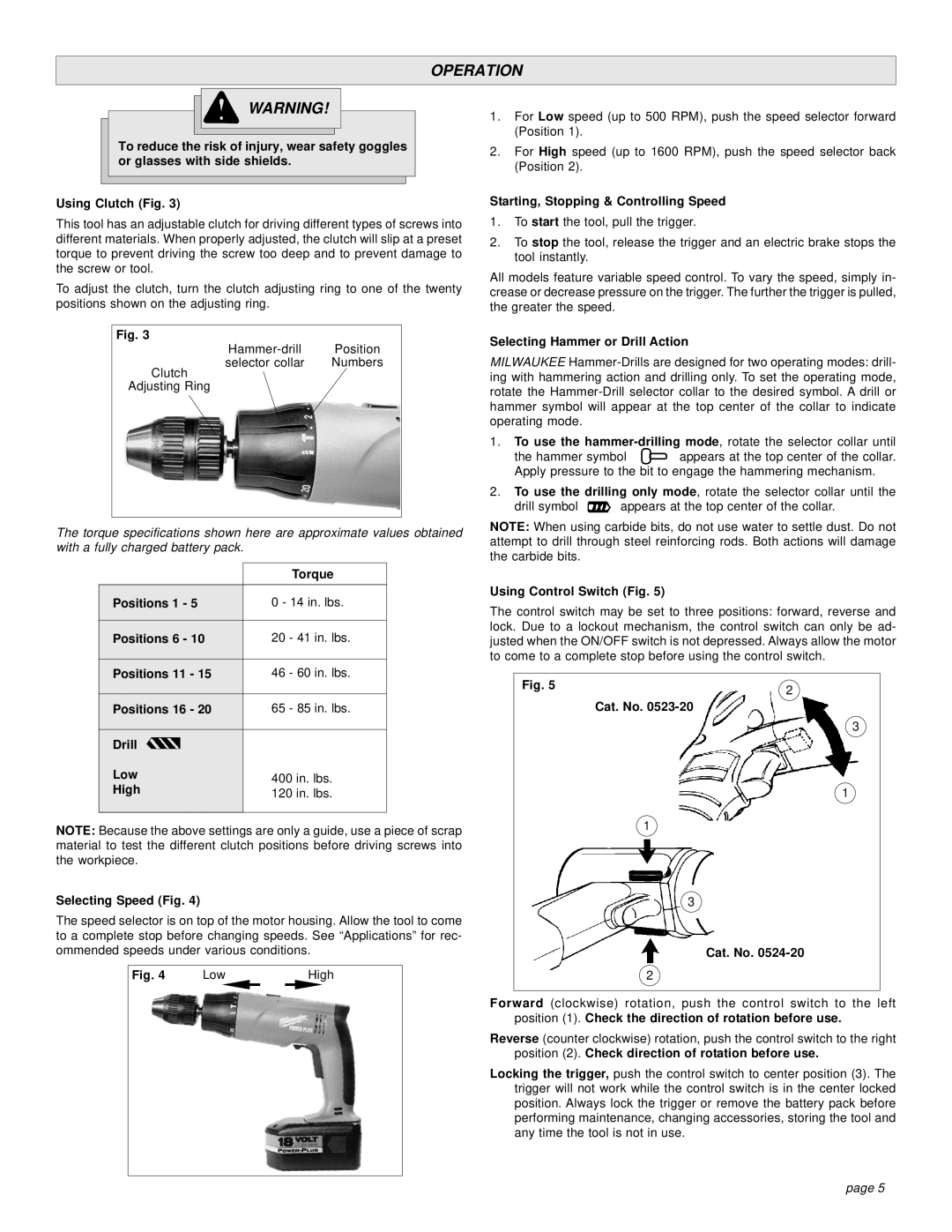
OPERATION
WARNING!
To reduce the risk of injury, wear safety goggles or glasses with side shields.
Using Clutch (Fig. 3)
This tool has an adjustable clutch for driving different types of screws into different materials. When properly adjusted, the clutch will slip at a preset torque to prevent driving the screw too deep and to prevent damage to the screw or tool.
To adjust the clutch, turn the clutch adjusting ring to one of the twenty positions shown on the adjusting ring.
Fig. 3
Position | |
selector collar | Numbers |
Clutch
Adjusting Ring
The torque specifications shown here are approximate values obtained with a fully charged battery pack.
1.For Low speed (up to 500 RPM), push the speed selector forward (Position 1).
2.For High speed (up to 1600 RPM), push the speed selector back (Position 2).
Starting, Stopping & Controlling Speed
1.To start the tool, pull the trigger.
2.To stop the tool, release the trigger and an electric brake stops the tool instantly.
All models feature variable speed control. To vary the speed, simply in- crease or decrease pressure on the trigger. The further the trigger is pulled, the greater the speed.
Selecting Hammer or Drill Action
MILWAUKEE
1.To use the
the hammer symbol ![]() appears at the top center of the collar.
appears at the top center of the collar.
Apply pressure to the bit to engage the hammering mechanism.
2.To use the drilling only mode, rotate the selector collar until the
drill symbol ![]() appears at the top center of the collar.
appears at the top center of the collar.
NOTE: When using carbide bits, do not use water to settle dust. Do not attempt to drill through steel reinforcing rods. Both actions will damage the carbide bits.
| Torque | |
|
| |
Positions 1 - 5 | 0 - 14 in. lbs. | |
|
| |
Positions 6 - 10 | 20 - 41 in. lbs. | |
|
| |
Positions 11 - 15 | 46 - 60 in. lbs. | |
|
| |
Positions 16 - 20 | 65 - 85 in. lbs. | |
|
| |
Drill |
| |
Low | 400 in. lbs. | |
High | ||
120 in. lbs. | ||
| ||
|
|
NOTE: Because the above settings are only a guide, use a piece of scrap material to test the different clutch positions before driving screws into the workpiece.
Selecting Speed (Fig. 4)
The speed selector is on top of the motor housing. Allow the tool to come to a complete stop before changing speeds. See “Applications” for rec- ommended speeds under various conditions.
Fig. 4 | Low |
| High |
| |||
|
|
|
|
Using Control Switch (Fig. 5)
The control switch may be set to three positions: forward, reverse and lock. Due to a lockout mechanism, the control switch can only be ad- justed when the ON/OFF switch is not depressed. Always allow the motor to come to a complete stop before using the control switch.
Fig. 5 | 2 |
| |
| Cat. No. |
3
1
1
3
Cat. No. 0524-20
2
Forward (clockwise) rotation, push the control switch to the left position (1). Check the direction of rotation before use.
Reverse (counter clockwise) rotation, push the control switch to the right position (2). Check direction of rotation before use.
Locking the trigger, push the control switch to center position (3). The trigger will not work while the control switch is in the center locked position. Always lock the trigger or remove the battery pack before performing maintenance, changing accessories, storing the tool and any time the tool is not in use.
page 5
